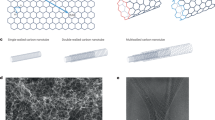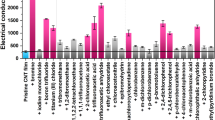Abstract
The relatively simple and robust architecture of microelectronic devices based on carbon nanotubes, in conjunction with their environmental sensitivity, places them among the leading candidates for incorporation into ultraportable or wearable chemical analysis platforms. We used single-walled carbon nanotube (SWNT) networks to establish a mechanistic understanding of the solid-state oxygen sensitivity of a Eu3+-containing dendrimer complex. After illumination with 365 nm light, the SWNT networks decorated with the Eu3+ dendrimer show bimodal (optical spectroscopic and electrical conductance) sensitivity towards oxygen gas at room temperature under ambient pressure. We investigated the mechanism of this unique oxygen sensitivity with time-resolved and steady-state optical spectroscopy, analysis of excited-state luminescence lifetimes and solid-state electrical transport measurements. We demonstrate a potential application of this system by showing a reversible and linear electrical response to oxygen gas in the tested range (5–27%).
This is a preview of subscription content, access via your institution
Access options
Subscribe to this journal
Receive 12 print issues and online access
$259.00 per year
only $21.58 per issue
Buy this article
- Purchase on Springer Link
- Instant access to full article PDF
Prices may be subject to local taxes which are calculated during checkout




Similar content being viewed by others
References
Rosenzweig, Z. & Kopelman, R. Development of a submicrometer optical fiber oxygen sensor. Anal. Chem. 67, 2650–2654 (1995).
Wolfbeis, O. S. Fiber-optic chemical sensors and biosensors. Anal. Chem. 80, 4269–4283 (2008).
Janata, J., Jasowicz, M., Vanysek, P. & DeVaney, D. M. Chemical sensors. Anal. Chem. 70, 179R–208R (1998).
Madou, M. J. & Morrison, S. R. Chemical Sensing with Solid State Devices (Academic Press, 1989).
Ramamoorthy, R., Dutta, P. D. & Akbar, S. A. Oxygen sensors: materials, methods, designs and applications. J. Mater. Sci. 38, 4271–4282 (2003).
Nerni, G. et al. A highly sensitive oxygen sensor operating at room temperature based on platinum-doped In2O3 nanocrystals. Chem. Commun. 6032–6034 (2005).
Dingsheng, W. et al. Ultralong single-crystalline Ag2S nanowires: promising candidates for photoswitches and room-temperature oxygen sensors. Adv. Mater. 20, 2628–2632 (2008).
Tans, S. J., Verschueren, A. R. M. & Dekker, C. Room-temperature transistor based on a single carbon nanotube. Nature 393, 49–52 (1998).
Avouris, P., Chen, Z. & Perebeinos, V. Carbon-based electronics. Nature Nanotech. 2, 605–615 (2007).
Snow, E. S., Perkins, F. K., Houser, E. J., Badescu, S. C. & Reinecke, T. L. Chemical detection with a single-walled carbon nanotube capacitor. Science 307, 1942–1945 (2005).
Kong, J. et al. Nanotube molecular wires as chemical sensors. Science 287, 622–625 (2000).
Kauffman, D. R. & Star, A. Carbon nanotube gas and vapor sensors. Angew. Chem. Int. Ed. 47, 6550–6570 (2008).
Collins, P. G., Bradley, K., Ishigami, M. & Zettl, A. Extreme oxygen sensitivity of electronic properties of carbon nanotubes. Science 287, 1801–1804 (2000).
Valentini, L, Armentano, I., Kenny, J. M., Bidali, S. & Mariani, A. Interaction of oxygen with nanocomposites made of n-type conducting polymers and carbon nanotubes: role of charge complex formation between nanotubes and poly(3-octylthiophene). Thin Solid Films 476, 162–167 (2005).
McDonagh, C., Burke, C. S. & MacCraith, B. D. Optical chemical sensors. Chem. Rev. 108, 400–422 (2008).
de Sousa, M. et al. An inhibit (INH) molecular logic gate based on 1,8-naphthalimide-sensitised europium luminescence. Photochem. Photobiol. Sci. 3, 639–642 (2004).
Wu, Z. et al. Transparent, conductive carbon nanotube films. Science 305, 1273–1276 (2004).
Bekyarova, E. et al. Mechanism of ammonia detection by chemically functionalized single-walled carbon nanotubes: in situ electrical and optical study of gas analyte detection. J. Am. Chem. Soc. 129, 10700–10706 (2007).
Kauffman, D. R. & Star, A. Simultaneous spectroscopic and solid-state electronic measurement of single-walled carbon nanotube devices. J. Phys. Chem. C 112, 4430–4434 (2008).
O'Connell, M. J., Eibergen, E. E. & Doorn, S. K. Chiral selectivity in the charge-transfer bleaching of single-walled carbon-nanotube spectra. Nature Mater. 4, 412–418 (2008).
Heller, D. A. et al. Optical detection of DNA conformational polymorphism on single-walled carbon nanotubes. Science 311, 508–511 (2006).
Hu, L., Hecht, D. S. & Grüner, G. Percolation in transparent and conducting carbon nanotube networks. Nano Lett. 4, 2513–2517 (2004).
Bekyarova, E. et al. Electronic properties of single-walled carbon nanotube networks. J. Am. Chem. Soc. 127, 5990–5995 (2005).
Cross, J. P., Lauz, M, Badger, P. D. & Petoud, S. Polymetallic lanthanide complexes with PAMAM–naphthalimide dendritic ligands: luminescent lanthanide complexes formed in solution. J. Am. Chem. Soc. 126, 16278–16279 (2004).
Savvate'ev, V. et al. Integrated organic light-emitting device/fluorescence-based chemical sensors. Appl. Phys. Lett. 81, 4652–4654 (2002).
Heller, I. et al. Identifying the mechanism of biosensing with carbon nanotube transistors. Nano Lett. 8, 591–595 (2008).
Saito, R., Fujita, M., Dresselhaus, G. & Dresselhaus, M. S. Electronic structure of chiral graphene tubules. Appl. Phys. Lett. 60, 2204–6206 (1992).
Katura, H. et al. Optical properties of single-wall carbon nanotubes. Synth. Metals 103, 2555–2558 (1999).
Chen, R. J. et al. Molecular photodesorption from single-walled carbon nanotubes. Appl. Phys. Lett. 79, 2258–2260 (2001).
Shim, M., Back, J. H., Ozel, T. & Kwon, K.-W. Effects of oxygen on the electron transport properties of carbon nanotubes: ultraviolet desorption and thermally induced processes. Phys. Rev. B 71, 205411 (2005).
Derycke, V., Martel, R., Appenzeller, J. & Avouris, P. Controlling doping and carrier injection in carbon nanotube transistors. Appl. Phys. Lett. 80, 2773–2775 (2002).
Hersam, M. C. Progress towards monodisperse single-walled carbon nanotubes. Nature Nanotech. 3, 387–394 (2008).
Lee, C. Y., Baik, S., Zhang, J., Masel, R. I. & Strano, M. S. Charge transfer from metallic single-walled carbon nanotube sensor arrays. J. Phys. Chem. B 110, 11055–11061 (2006).
Hecht, D. S. et al. Bioinspired detection of light using a porphyrin-sensitized single-wall carbon nanotube field effect transistor. Nano Lett. 6, 2031–2036 (2006).
Star, A., Lu, Y., Bradley, K. & Grüner, G. Nanotube optoelectronic memory devices. Nano Lett. 4, 1587–1591 (2004).
Borghetti, J. et al. Optoelectronic switch and memory devices based on polymer-functionalized carbon nanotube transistors. Adv. Mater. 18, 2535–2540 (2006).
Chua, L.-L. et al. General observation of n-type field-effect behavior in organic semiconductors. Nature 434, 194–199 (2005).
Hartstein, A. & Young, D. Identification of electron traps in thermal silicon dioxide films. Appl. Phys. Lett. 38, 631–633 (1981).
Kim, W. et al. Hysteresis caused by water molecules in carbon nanotube field-effect transistors. Nano Lett. 3, 193–198 (2003).
Pantelides, S. T. The electronic structure of impurities and defects in SiO2 . Thin Solid Films 89, 103–108 (1982).
Giordano, L., Sushko, P. V., Pacchioni, G. & Shluger, A. L. Electron trapping at point defects on hydroxylated silica surfaces. Phys. Rev. Lett. 99, 136801 (2007).
Anghel, C. et al. Nanotube transistors as direct probes of the trap dynamics at dielectric–organic interfaces of interest in organic electronics and solar cells. Nano Lett. 8, 3619–3625 (2008).
Queisser, H. J. Nonexponential relaxation of conductance near semiconductor interfaces. Phys. Rev. Lett. 54, 234–236 (1985).
Bünzli, J.-C. G. & Piguet, C. Taking advantage of luminescent lanthanide ions. Chem. Soc. Rev. 34, 1048–1077 (2005).
Hangleiter, A. Recombination of correlated electron-hole pairs in two-dimensional semiconductors. Phys. Rev. B 48, 9146–9149 (1993).
Kajihara, K. et al. Interstitial oxygen molecules in amorphous SiO2. II. The influence of common dopands (SiOH, SiF, and SiCl groups) and fictive temperature on the decay of single photoluminescence. J. Appl. Phys. 98, 013528 (2005).
Aroutiounian, V. Metal oxide hydrogen, oxygen, and carbon monoxide sensors for hydrogen setups and cells. Int. J. Hydrogen Energy 32, 1145–1158 (2007).
Sorescu, D. C., Jordan, K. D. & Avouris, P. Theoretical study of oxygen adsorption on graphite and the (8,0) single-walled carbon nanotube. J. Phys. Chem. B 105, 11227–11232 (2001).
LabVIEW 7.1 (National Instruments Corporation, Austin, Texas, 2004).
OriginPro 7.0 (OriginLab Corporation, Northampton, Massachusetts, 2002).
Lide, D. R. CRC Handbook of Chemistry and Physics, 85th edn (CRC, 2005).
Acknowledgements
The authors thank D. H. Waldeck for his comments, and acknowledge the facilities, scientific and technical assistance of the Materials Micro-Characterization Laboratory of the Department of Mechanical Engineering and Materials Science, Swanson School of Engineering, University of Pittsburgh. This work was performed in support of ongoing research in sensor systems and diagnostics at the National Energy Technology Laboratory under RDS contract DE-AC26-04NT41817. This work was partially supported through the National Science Foundation (Grant DBI-0352346).
Author information
Authors and Affiliations
Contributions
D.R.K fabricated devices, performed electron microscopy, optical absorption and EDX spectroscopy, electrical conductance measurements and gas sensor studies. C.M.S. performed photoluminescence spectroscopy and luminescence lifetime measurements. H.U. synthesized and characterized the Eu8 dendrimer. All authors contributed to the design of the experiments, interpretation of the results and writing of the manuscript.
Corresponding authors
Supplementary information
Supplementary information
Supplementary information (PDF 3528 kb)
Rights and permissions
About this article
Cite this article
Kauffman, D., Shade, C., Uh, H. et al. Decorated carbon nanotubes with unique oxygen sensitivity. Nature Chem 1, 500–506 (2009). https://doi.org/10.1038/nchem.323
Received:
Accepted:
Published:
Issue Date:
DOI: https://doi.org/10.1038/nchem.323



